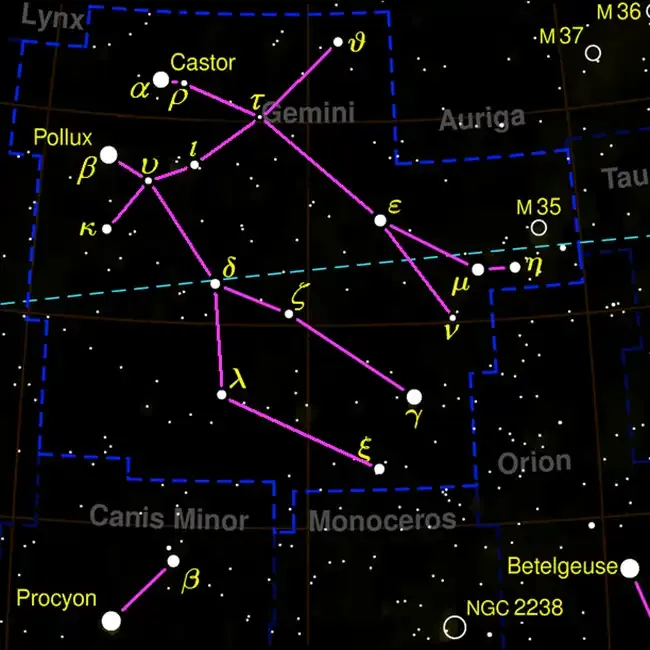
Gemini is one of the twelve zodiac constellations, representing the twins Castor and Pollux from Greek mythology. It is a prominent constellation in the northern hemisphere and is located between Taurus and Cancer. The constellation is best known for its two brightest stars, Castor and Pollux, which represent the heads of the twins. The rest of the constellation forms a rough rectangle shape, symbolizing the bodies of the twins.
Key Features
Gemini is recognized for its twin stars, Castor and Pollux, which are easy to identify in the night sky due to their brightness and close proximity to each other. Castor, the second-brightest star, is a multiple star system composed of six stars that appear as a single point of light to the naked eye. Pollux, slightly brighter than Castor, is a giant star that has been confirmed to host an exoplanet.
The constellation also contains several other stars and deep-sky objects, including the Eskimo Nebula (NGC 2392), a planetary nebula, and the open star cluster M35, which is a popular target for amateur astronomers.
Mythology
In Greek mythology, the constellation Gemini represents the twin brothers Castor and Pollux, sons of Leda. Although they had different fathers—Castor was the mortal son of King Tyndareus, while Pollux was the divine son of Zeus—the two were inseparable and shared a deep bond. According to the myth, when Castor was killed, Pollux, being immortal, was devastated and begged Zeus to let him share his immortality with his brother. Zeus granted this wish by placing both brothers in the sky as the constellation Gemini.
The twins were also associated with sailors, as they were believed to protect ships at sea. The bright stars Castor and Pollux were seen as guiding lights, leading sailors safely through storms.
Notable Stars
- Pollux (Beta Geminorum): The brightest star in Gemini, Pollux is an orange giant star located about 34 light-years from Earth. It is also notable for its exoplanet, Pollux b, which is about 2.3 times the mass of Jupiter.
- Castor (Alpha Geminorum): Castor is a multiple star system consisting of six individual stars grouped into three binary pairs. It is about 51 light-years from Earth and is the second-brightest star in the constellation.
- Alhena (Gamma Geminorum): A bright, white star that marks one of the twins' feet, Alhena is about 105 light-years from Earth.
- Mebsuta (Epsilon Geminorum): A supergiant star located approximately 840 light-years from Earth, Mebsuta is a prominent star in the constellation.
Visibility
Gemini is visible in both the northern and southern hemispheres. In the northern hemisphere, it is best seen from late autumn to early spring, with optimal visibility from December to March. In the southern hemisphere, Gemini can be seen in the summer months. The constellation reaches its highest point in the sky around midnight in February, making this the best time for observation.
Tips for Observing
- Finding Gemini: To locate Gemini, start by finding Orion, one of the most recognizable constellations in the night sky. Gemini lies to the northeast of Orion. The two bright stars, Castor and Pollux, will help you identify the constellation.
- Best Time to Observe: The best time to observe Gemini is during the late evening in the winter months when it is high in the sky. Clear, dark skies away from city lights will enhance visibility.
- Using Binoculars or a Telescope: For those interested in observing deep-sky objects, binoculars or a small telescope can help you view the Eskimo Nebula or the star cluster M35, both located within Gemini.
- Stargazing Events: Consider joining a stargazing event or visiting an observatory during the winter months to get a guided tour of Gemini and other winter constellations.
